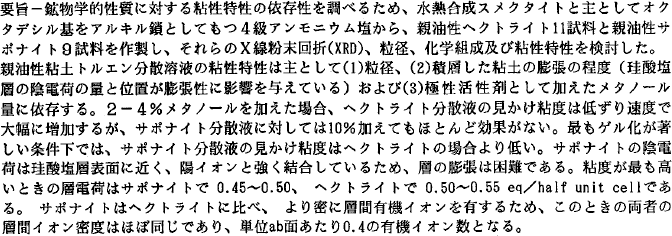Crossref Citations
This article has been cited by the following publications. This list is generated based on data provided by
Crossref.
Torii, K.
Iwasaki, T.
Onodera, Y.
and
Hatakeda, K.
1991.
Chemistry of Microporous Crystals, Proceedings of the International Symposium on Chemistry of Microporous Crystals.
Vol. 60,
Issue. ,
p.
81.
Kloprogge, J. Theo
Breukelaar, Johan
Jansen, J. Ben H.
and
Geus, John W.
1993.
Development of Ammonium-Saponites from Gels with Variable Ammonium Concentration and Water Content at Low Temperatures.
Clays and Clay Minerals,
Vol. 41,
Issue. 1,
p.
103.
Lagaly, G.
1993.
Tonminerale und Tone.
p.
358.
Kloprogge, J. Theo
Breukelaar, Johan
Geus, John W.
and
Jansen, J. Ben H.
1994.
Characterization of Mg-Saponites Synthesized from Gels Containing Amounts of Na+, K+, Rb+, Ca2+, Ba2+, or Ce4+ Equivalent to The CEC of the Saponite.
Clays and Clay Minerals,
Vol. 42,
Issue. 1,
p.
18.
Biasci, Luca
Aglietto, Mauro
Ruggeri, Giacomo
and
Ciardelli, Francesco
1994.
Functionalization of montmorillonite by methyl methacrylate polymers containing side-chain ammonium cations.
Polymer,
Vol. 35,
Issue. 15,
p.
3296.
Konta, Jiří
1995.
Clay and man: clay raw materials in the service of man.
Applied Clay Science,
Vol. 10,
Issue. 4,
p.
275.
Biasci, Luca
Aglietto, Mauro
Ruggeri, Giacomo
and
D′Alessio, Aldo
1995.
Functionalization of montmorillonite by acrylamide polymers containing side‐chain ammonium cations.
Polymers for Advanced Technologies,
Vol. 6,
Issue. 10,
p.
662.
Kloprogge, J. Theo
Komarneni, Sridhar
and
Amonette, James E.
1999.
Synthesis of Smectite Clay Minerals: A Critical Review.
Clays and Clay Minerals,
Vol. 47,
Issue. 5,
p.
529.
Kloprogge, J.T.
and
Frost, R.L.
2000.
The effect of synthesis temperature on the FT-Raman and FT-IR spectra of saponites.
Vibrational Spectroscopy,
Vol. 23,
Issue. 1,
p.
119.
Breu, Josef
Seidl, Wolfgang
and
Stoll, Alexander
2003.
Fehlordnung bei Smectiten in Abhängigkeit vom Zwischenschichtkation.
Zeitschrift für anorganische und allgemeine Chemie,
Vol. 629,
Issue. 3,
p.
503.
Ryu, Kyoung-Won
Jang, Young-Nam
Chae, Soo-Chun
Bae, In-Kook
and
Choi, Sang-Hoon
2006.
Hydrothermal synthesis of smectite from dickite.
Clays and Clay Minerals,
Vol. 54,
Issue. 1,
p.
80.
Mariychuk, Ruslan
Baumgartner, Alexander
Wagner, Friedrich E.
Lerf, Anton
Dubbe, Andreas
Moos, Ralf
and
Breu, Josef
2007.
Synthesis, Structure, and Electric Conductivity of Ferrous Tainiolite and Its Oxidative Conversion into Coarse-Grained Swellable Smectite.
Chemistry of Materials,
Vol. 19,
Issue. 22,
p.
5377.
Jaber, Maguy
and
Miehé-Brendlé, Jocelyne
2008.
Synthesis, characterization and applications of 2:1 phyllosilicates and organophyllosilicates: Contribution of fluoride to study the octahedral sheet.
Microporous and Mesoporous Materials,
Vol. 107,
Issue. 1-2,
p.
121.
Fillery, Scott P.
Koerner, Hilmar
Drummy, Lawrence
Dunkerley, Erik
Durstock, Michael F.
Schmidt, Daniel F.
and
Vaia, Richard A.
2012.
Nanolaminates: Increasing Dielectric Breakdown Strength of Composites.
ACS Applied Materials & Interfaces,
Vol. 4,
Issue. 3,
p.
1388.
Sánchez, Tatiana
Salagre, Pilar
and
Cesteros, Yolanda
2013.
Ultrasounds and microwave-assisted synthesis of mesoporous hectorites.
Microporous and Mesoporous Materials,
Vol. 171,
Issue. ,
p.
24.
Jaber, M.
Komarneni, S.
and
Zhou, C.-H.
2013.
Handbook of Clay Science.
Vol. 5,
Issue. ,
p.
223.
Bhatt, Juggnu
Somani, Rajesh S.
Mody, Haresh M.
and
Bajaj, Hari C.
2013.
Rheological study of organoclays prepared from Indian bentonite: Effect of dispersing methods.
Applied Clay Science,
Vol. 83-84,
Issue. ,
p.
106.
Gebretsadik, Fiseha B.
Salagre, Pilar
and
Cesteros, Yolanda
2014.
Use of polymer as template in microwave synthesis of saponite. Study of several factors of influence.
Applied Clay Science,
Vol. 87,
Issue. ,
p.
170.
Gebretsadik, Fiseha B.
Mance, Deni
Baldus, Marc
Salagre, Pilar
and
Cesteros, Yolanda
2015.
Microwave synthesis of delaminated acid saponites using quaternary ammonium salt or polymer as template. Study of pH influence.
Applied Clay Science,
Vol. 114,
Issue. ,
p.
20.
Hong, Joung Sook
2016.
Aggregation of hydrophilic/hydrophobic montmorillonites at oil–water interface.
Applied Clay Science,
Vol. 119,
Issue. ,
p.
257.





